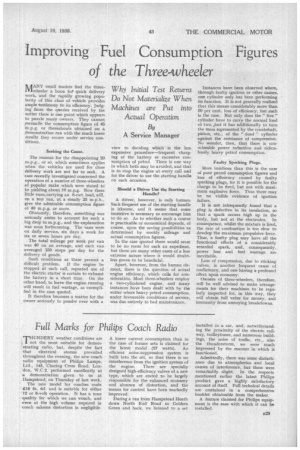Improving Fuel Consumption Figures
Page 39

If you've noticed an error in this article please click here to report it so we can fix it.
of the Three-wheeler Why Initial Test Returns Do Not Materialize When Machines are Put into Actual Operation By A Service Manager
if ANY small traders find the threeIV1wheeler a boon foe quick delivery work, and the rapidly growing popularity of this class of vehicle provides ample testimony to its efficiency. Judging from the queries received by the writer there is one point which appears to puzzle many owners. They cannot reconcile the consumption figure of 45 M.p.g. or thereabouts obtained on a ,demonstration run with the much lower results they secure under service conditions.
Seeking the Cause.
The reasons for the disappointing 20 m.p.g., or so, which sometimes applies when the vehicles are used for close delivery work are not far to seek. A case recently investigated concerned the operation of a number of three-wheelers of popular make which were stated to be yielding about 10 m.p.g. Now these little vans, carrying an 8-cwt. load, will, on a test run, at a steady 25 m.p.h., give the admirable consumption figure of 40 m.p.g. or more.
Obviously, therefore, something was seriously amiss to account for such a big drop in m.p.g., and the explanation was soon forthcoming. The vans were on daily service, six days a week for six or seven hours per day.
• The total mileage per week per van was 40 on an average, and each van averaged 150 stops per day for the delivery of goods.
Such conditions as these present a difficult problem. If the engine be stopped at each call, repeated use of the electric starter is certain to exhaust the battery in a short time. On the other hand, to leave the engine running will result in fuel wastage, as exemplified in the case quoted.
It therefore becomes a matter for the owner -seriously to ponder over with a view to deciding which is the less expensive procedure—frequent charging of the battery or excessive consumption of petrol. There is one way in which both may be avoided, and that is to stop the engine at every call and for the driver to use the starting handle on each occasion.
Should a Driver Use the Starting Handle?
A driver, however, is only human. Such frequent use of the starting handle is irksome, and it seems that some incentive is necessary to encourage him to do so. As to whether such a course is practicable or economical depends, of course, upon the saving possibilities as determined by weekly mileage and actual consumption figures.
In the case quoted there would seem to be no room for such an expedient, but there are many other cases of a less extreme nature where it would doubtless prove to be beneficial.
Apart, however, from the human elemeat, there is the question of actual engine efficiency, which calls for consideration. Most three-wheelers employ a two-cylindered engine, and many instances have been dealt with by the writer where heavy petrol consumption, under favourable conditions of service, was due entirely to bad maintenance.
Instances have been observed where, through faulty ignition or other causes, one cylinder only has been performing its function. It is not generally realized that this means considerably more than 50 per cent. loss of efficiency, but such is the case. Not only does the "live" cylinder have to carry the normal load of two,,hut it has additionally to turn the mass represented by the crankshaft, piston, etc., of the "dead " cylinder against the resistance of compression. No wonder, then, that there is considerable power reduction and ridiculously heavy petrol consumption, Faulty Sparking Plugs.
More insidious than this is the case of poor petrol consumption figures and loss of efficiency caused by faulty sparking plugs, for it is possible for the charge to be fired, but not with maximum explosive force. Thus there may be no visible evidence of ignition failure.
It is not infrequently found that a plug is defective in its insulation, so that a spark occurs high up in the body, but not at the electrodes. In consequence, whilst the mixture is fired, the rate of combustion is too slow to develop the maximum propulsive force. Thus, a faulty plug may have all the functional effects of a considerably retarded spark, and, consequently, power loss and fuel wastage are inevitable,
Loss of compression, due to sticking valves,is another frequent cause of inefficiency, and one having a profound effect upon economy.
Owners of three-wheelers, therefore, will be well advised to make arrangements for their machines to be regularly inspected for, in this way, they will obtain full value for money, and immunity" from annoying breakdowns.




















































































